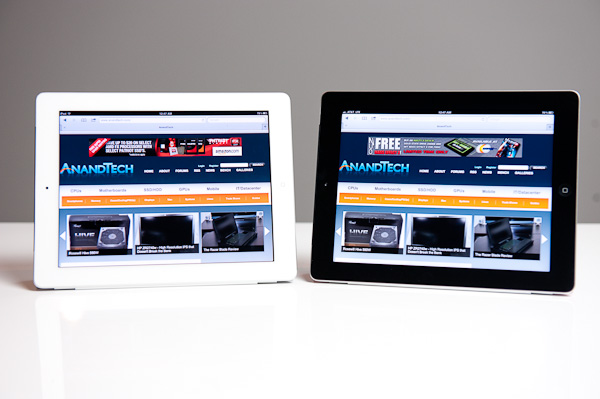The Apple iPad Review (2012)
by Vivek Gowri & Anand Lal Shimpi on March 28, 2012 3:14 PM ESTSince Apple launched the first iPad two years ago, the tablet market has evolved rapidly. While slate tablets were nothing new, the original iPad was the first serious tablet to be built around smartphone components and a user interface designed specifically for touchscreen input. The hardware was enough to run the OS smoothly while maintaining good battery life, the thin and light form factor lent itself to easy portability, and the touch-based user experience was miles better than earlier devices based on desktop operating systems.
We take it for granted now, but this was all news back in 2010, and the iPad was practically in a category of its own, with no real competitors to speak of. After Apple started shipping the iPad, the segment basically exploded—we had Google jump in with Honeycomb, HP got into it (and then out of it) with webOS, RIM had a go with the PlayBook, Amazon pushed the Kindle line into the tablet space, and Microsoft created its next release of Windows with tablets in mind. Along the way, Apple updated the iPad, both on the software side with multitasking, a new notifications system, and a myriad of UI updates, as well as launching second generation iPad hardware. The iPad 2 was a comprehensive update, bringing a dual core processor, unrivaled graphics performance, cameras fore and aft, and a ground up redesign that brought a thinner and lighter form factor.
The iPad 2 was a significant improvement over the original—faster, more portable, and generally a far more polished device. Not that it was perfect: iOS 4 still had issues with smooth multitasking and an archaic notifications system, the cameras were mediocre, and the XGA display, while a great quality panel, didn’t have the kind of pixel density expected of a premium mobile device. The iPad 2 hit market around the same time as Honeycomb (in Motorola’s Xoom) early last year, and at first Apple still held a major edge in terms of hardware. As more impressive Honeycomb devices like Samsung’s Galaxy Tab 10.1 and the ASUS Transformer Prime were launched, along with Ice Cream Sandwich looming on the horizon, Android became a much more viable tablet alternative to iOS. And with Microsoft planning for a major push later this year for ARM-based Windows 8 tablets centered around the Metro UI, Apple has never faced such stiff competition in the tablet space. Which brings us to the third generation of iPad hardware.
It has a display resolution that dwarfs most high-end desktop displays. The panel also puts a real emphasis on quality, not just resolution. For a computing device targeted squarely at the consumer market, both of these things are rarities.
Its SoC is the absolute largest ever squeezed into an ARM based tablet. The chip itself is even bigger than what you find in most mainstream notebooks. It’s expensive, it puts out a ton of heat and it offers a tremendous GPU performance advantage over anything else in its class.
And it has a battery that’s larger than what ships in the current crop of similarly sized ultraportables and Ultrabooks.
The new iPad doesn’t significantly change the tablet usage paradigm, but it does put all previous attempts at building hardware in this space to shame. It’s the sort of no holds barred, performance at any expense design that we’re used to seeing from enthusiast PC component vendors—but in a tablet...from Apple.
Welcome to the new iPad.












234 Comments
View All Comments
Steelbom - Thursday, March 29, 2012 - link
I'm curious why we didn't see any graphics benchmarks from the UDK like with the iPhone 4S review?Craig234 - Thursday, March 29, 2012 - link
Wow, this is good to buy... 'if you are in desperate need for a tablet'?That's a pretty weak recommendation, I expected a much stronger endorsement based on the review.
Chaki Shante - Friday, March 30, 2012 - link
Great, thorough review, thanks Anand et al.Given the sheer size of the SoC (like 4x larger then Tegra2 or OMAP4430, and 2x Tegra3), you'd bet Apple has the fastest current SoC, at least GPU-wise.
This SoC is just huge and Apple's margin is certainly lowered. Is this sustainable on the long run ?
I wonder if any other silicon manufacturer could make same size devices (not technologically but from a price perspective) and expect to sell them.
dagamer34 - Friday, March 30, 2012 - link
No one else needs to crank out so many chips that are the same. Also, other companies will be waiting long enough to use 28nm, so there's little chance they'll be hitting the same size as the A5X on 45nm.Aenean144 - Friday, March 30, 2012 - link
Since Apple is both the chip designer/licensee and hardware vendor, it saves them the cost of paying a middleman. Ie, Nvidia has to make a profit on a Tegra sale, Apple does not, and can afford a more expensive chip from the fab compared to the business component chain from Asus to Nvidia to GF/TSMC and other IP licensees.I bet there is at least 50% margin somewhere in the transaction chain from Asus to Nvidia to GF/TSMC. Apple may also have a sweetheart IP deal from both ARMH and IMGTEC that competitors may not have.
shompa - Friday, March 30, 2012 - link
@Aenean144Tegra2 cost 25 dollars for OEMs and 15 dollars to manufacture. A5 cost Apple 25 dollars to manufacture. By designing its own SoC Apple got 30% larger SoC at the same price as Android OEMs.
Tegra3 is huge. That is a problem for Nvidia. It costs at least 50% more to manufacture. Nvidia is rumored to charge 50 dollar for the SoC.
A5X is 50%+ larger then Tegra3. Depending of yields it cost Apple 35-50 dollar per SoC.
The integrated model gives Apple cheaper SoCs, but also custom designed for their needs. Apple have a long history of Accelerating stuff in its OS. Back in 2002 it was AltiVec. Encoding a DVD on a 667mhz powerbook took 90 minutes. The fastest X86 AMD 1.5ghz it took 15 hours. (and it was almost impossible to have XP not bluescreen for 15 hours under full load). Since 2002 Apple accelerate OSX with Quarz Extreme. Both these techniques are now used in iOS with SIMD acceleration and GPU acceleration. Its much more elegant then the brute force X86 approach. Integrated makes it possible to use slower, cheaper and more efficient designs.
shompa - Friday, March 30, 2012 - link
The A5X SoC is a disaster. Its a desperation SoC that had to be implemented when TSMC 28nm process slipped almost 2 years. That is the reason why Apple did not tape out a 32nm A5X on Samsung. PA Semi had to crank out a new tapeout fast with existing assets. So they took the A5 and added 2 more graphics core.The real A6 SoC is probably ready since long back, but TSMC cant deliver enough wafers. The rumored tapeout for A6 was mid 2011. Apple got test wafers from TSMC in june and another batch of test wafers in october. Still at this point Apple believed they would use TSMC for Ipad3.
ARM is about small, cheap and low power SoCs. That is the future of computing. The A5X is larger then many X86 chips. Technically Intel manufactures many of its CPUs cheaper then Apple manufactures the A5X SoC. That is insane.
stimudent - Friday, March 30, 2012 - link
Products reviews are fun to look at, but where there's a bright side, there is always a dark side. Maybe product scoring should also reflect how a manufacturer treats its employees.name99 - Friday, March 30, 2012 - link
You mean offers them a better wage than they could find in the rest of China, and living conditions substantially superior to anywhere else they could work?Yes, by all means let's use that scoring.
Or perhaps you'd like to continue to live your Mike Daisey dystopia because god-forbid that the world doesn't conform to your expectations?
Craig234 - Friday, March 30, 2012 - link
I'm all for including 'how a company treats its employees' and other social issues; but I'd list them separately, not put them in a product rating.